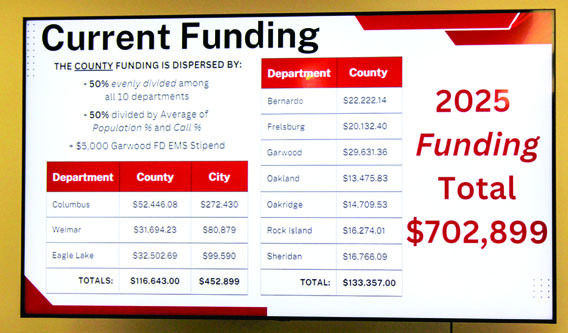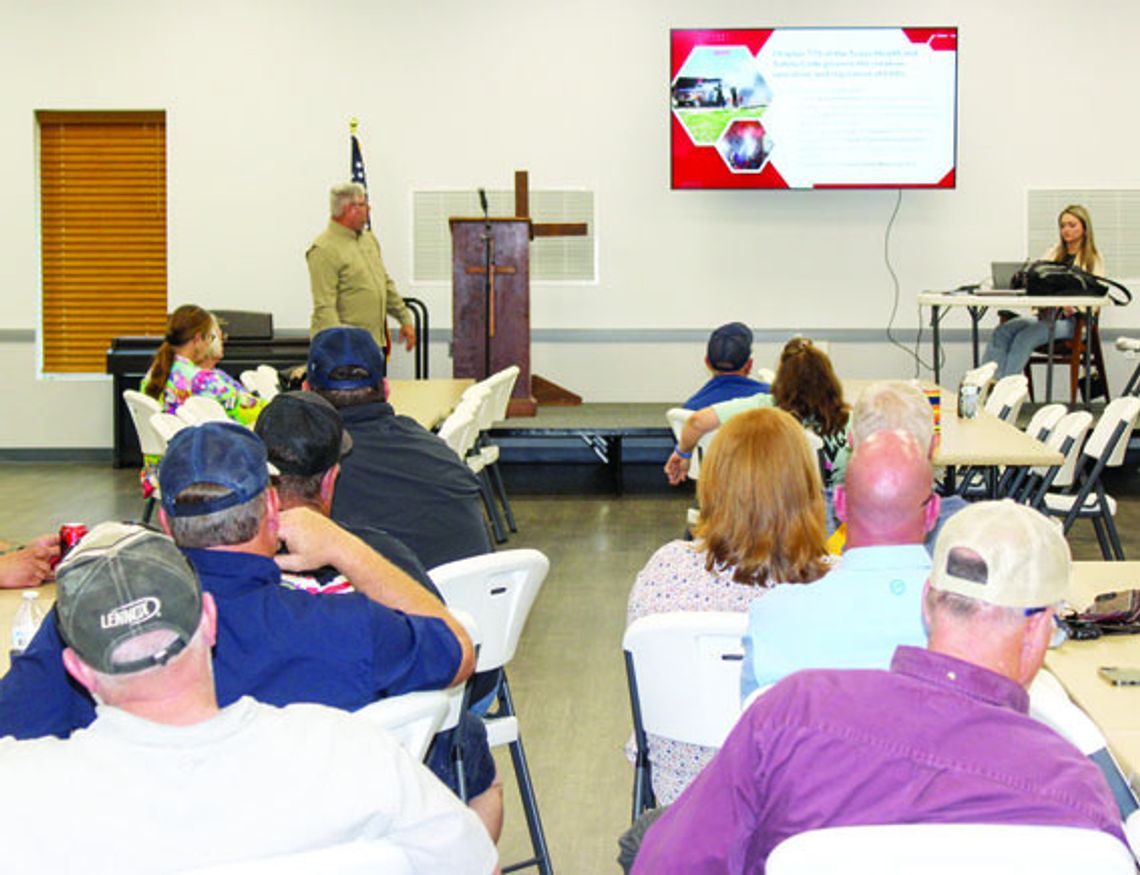COLORADO COUNTY FIREFIGHTERS ASSOCIATION
Voters to decide if ESD will be created in May 3 election
The Colorado County Firefighters Association held their last townhall meeting last Thursday, April 10 in Columbus, in attempts to inform the public about the proposition ahead of the May 3 general election.
The meeting took place at the St. Paul Lutheran Church Lighthouse on 201 Veterans Drive, attended by more than 30 people including firefighting personnel from across the county and residents.
The townhalls have been held to provide informative information to the public about the proposed Colorado County Emergency Services District #1, otherwise known as the Colorado County ESD, which would unify all the fire departments across the county to be aided by taxpayer money rather than having to solely rely on donations.
Currently, county funding is dispersed by 50% evenly divided among all 10 departments and 50% divided by average of population and call percentage. The three municipalities also receive funding from their cities, totaling $702,899 across the 10 departments.
A slideshow presentation showcased the donation disparity between the 10 departments, with departments such as Garwood, Frelsburg, Oakridge and Weimar totaling over $250,000 each in donations over the course of the last three years while departments in Oakland and Sheridan not even reaching the $100,000 mark combined in the same time frame.
A proposed tax rate of $.10 for every $100 would be the maximum tax cap for the ESD but would not have to be passed at that rate and could be passed at a lower rate if deemed to be unnecessary for the needs of all the departments across the county.

An infographic depicting the current funding provided to the 10 VFDs in Colorado County by the county and municipalities.
Additionally, the ESD would only pass if a majority of voters throughout the county voted for it and would only apply for the municipalities that voted to incorporate it rather than the ones that didn’t.
For example, if the majority of Colorado County voters voted to approve the ESD, but the majority of voters in Eagle Lake’s municipality opted not to, the ESD would not pass in Eagle Lake and its incorporated areas, but would pass in the municipalities and incorporated areas that had a majority vote for the ESD’s approval.
The “Methodology for compensation” could come in several different avenues as to how the tax money would be dispersed across the three different departments. Some examples are
• The Share-and-Share-Alike method: splitting the compensation for each department equally.
• The Per-Call Basis method: Apportioning resources based on the documented activity of each department.
• Area-Percent of Territory Covered: Based on the amount of area each department covers.
• The As-Needed or Budgeted approach: Each department will be required to clear all expenses with the ESD before an expenditure is made.
An ESD board would be created if the proposition passes, allowing a governing body to set budgets, approve expenditures, gauge needs and communicate with County Commissioners on the needs of the 10 departments across the county.
One common theme that the association has been pushing is that grants, fundraisers and donations are no longer consistent, guaranteed and enough to sustain departments and their needs, considering inflation and the rising costs of maintaining and purchasing equipment.
Historically, the average cost of purchasing a new fire engine has sextupled since the 1980’s to the current day, with an engine going from costing $100,000-$150,000 to a whopping $600,000 to over $1.2 million in 2025.
Gear for a single firefighter in 2025, both structural and wildland, would cost an estimated $12,125 to $20,700, and with 246 volunteers across the 10 departments, with gear expiring every 10 years, the cost of replacement if hit all at once could range from $3 million to $5 million.
Various departments across the county highlighted the needs for each of their departments, including but not limited to needs for:
• A new engine to replace a 34-year-old engine in Eagle Lake (they should be retired after 25 years)
• A working radio system (Eagle Lake) Sheridan with a new brush truck and station upgrade
• A class A pumper truck, with the current one being 24 years old ( Weimar)
• A wildland truck combo ( Frelsburg)
• Utility upgrade for station (Columbus) The estimated price for all the needs across the departments in the county is estimated to be around $2 million, nowhere near the yearly funds provided by the county and three municipalities.
The ESD, if established, would not change the volunteer status of the departments, meaning the departments would not be paid and still be fully volunteer based. The ESD would allow “volunteers to focus their time training on skills that can save lives rather than focusing on fundraising for their existence.”
The ownership of assets would also rely on the specifics of the equipment purchases and how they are brought about. Anything purchased with taxpayer money would belong to the public, anything purchased by a singular department would belong to that department. If the asset is purchased using both public money and department funds, the ESD “may not retain total ownership of the asset but does own a proportionate interest in the asset.”
If that point is reached, the asset’s ownership would be directly addressed in the contract of the asset.
The vote for the proposed ESD will be on the ballot for the Saturday, May 3 general election, with early voting to start on Tuesday, April 22.
.jpg)

